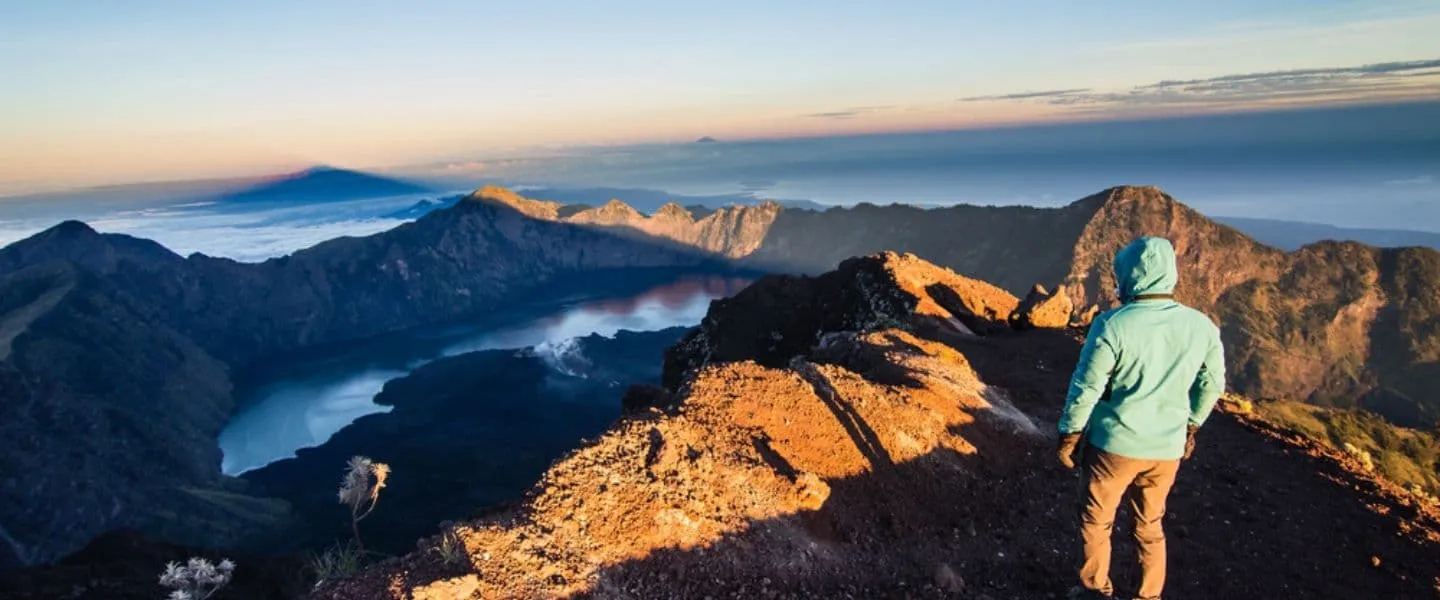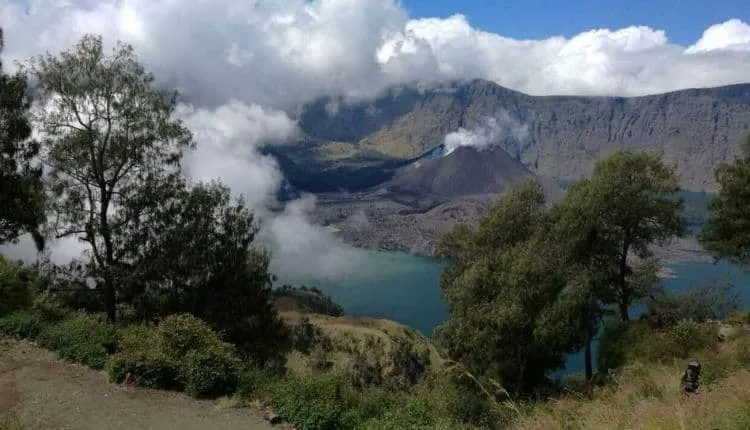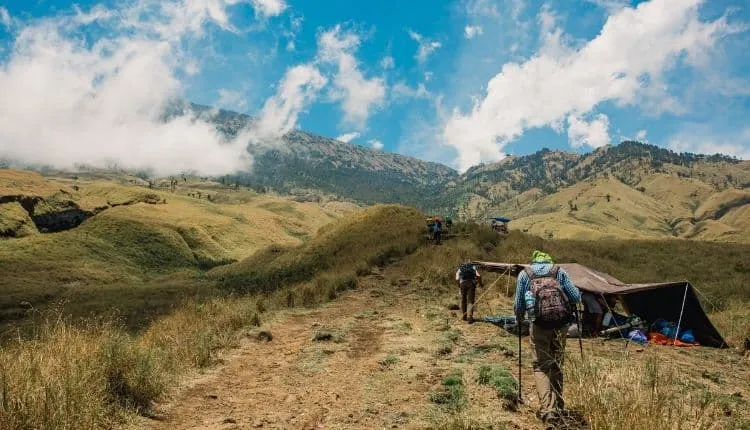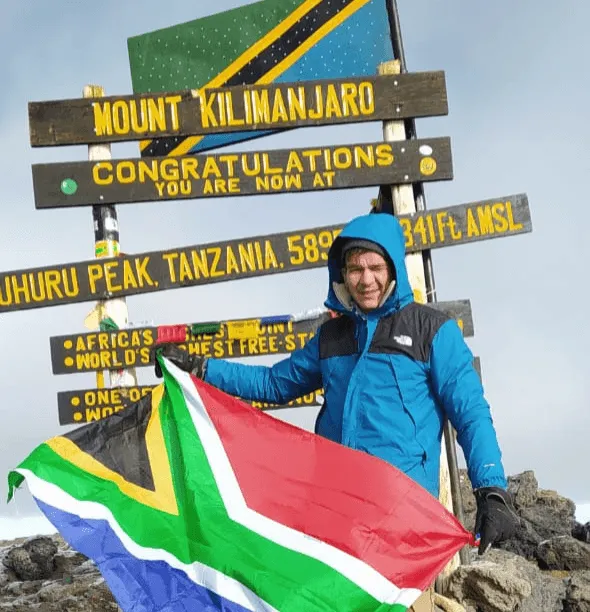For years a Rinjani trekking has been a popular outing for backpackers who want to sweat out some of the party liquids they have been enjoying elsewhere in South East Asia. Trekking on the second highest volcano in Indonesia has been on the bucket lists of plenty of backpackers and visitors to Indonesia. Mount Rinjani, in Indonesian known as Gunung Rinjani, is an active volcano on the island of Lombok in Indonesia.
Mount Rinjani Trekking: Everything You Need to Know

Contents
- Mount Rinjani Height
- Rinjani Volcano - An Active One
- Rinjani Summit or Crater Rim Trek - The Differences
- Start from Sembalun or Senaru - The Differences
- Gunung Rinjani Tour Package - 2 Day
- How To Get To Mount Rinjani Lombok
- Best Season for Climbing Mount Rinjani
- Rinjani Trekking in One Day or Solo - Rather Not
- Hiking Mount Rinjani Difficulty
- Rinjani Trekking Packing List
- Porters on your Mt. Rinjani trek
- What To Do After Your Mount Rinjani Trek
- How To Identify and Prevent AMS On The Mount Rinjani Summit Trek?
- Where Can I Book the Mount Rinjani Summit Trek?
Mount Rinjani Height
Mount Rinjani is 3,726 m (12,224 ft) high and on the top, you can find a 6-by-8.5 kilometer caldera, which presumably is 200 meters deep. For the Sasak tribe and Hindu people, the mountain is sacred and religious activities are often done on the mountain. Rinjani, however, receives the most attention from trekkers.
Book Now
Rinjani Volcano - An Active One
Every year, thousands of people find their way to Gunung Rinjani National Park and trek to the crater rim of Gunung Rinjani or find their way to the peak. For years the mountain provided a living for many people on the lower slopes; in the villages of Senaru and Sembalun, plenty of people make their living from the trekkers and backpackers who have found their way to this side of Lombok.Being an active volcano, the trails to the peak have been closed from time to time. It wasn’t however until the morning of the 29th of July 2018 that all the Rinjani trails were closed for what felt like an endless time. The long wait is over! Are you ready to conquer Mount Rinjani?

Rinjani Summit or Crater Rim Trek - The Differences
There are two main options to consider when you are interested in a Mount Rinjani trekking. When doing your research, you will read the words Summit Trek and Crater Rim again and again. The differences are not always as obvious as they may seem. The Crater Rim is at an altitude of 2,641 meters and from here you can see Segara Anak, the lake in the caldera, and the summit of Mount Rinjani clearly. The Crater Rim trek can be comfortably done in two days and one night. It is the easiest route for a great impression of the volcano in all its splendor. The sunset from Mount Rinjani is unforgettable.
On a clear evening, the Gili Islands, Bali, and Mt. Agung can be seen to the west. The same you can see from the Summit of course. The Summit trek is for peak baggers, who those want to climb Mount Rinjani. It’s still trekking. You won’t need ropes or anything similar, but it is the most strenuous version of Rinjani trekking. Although it is easiest to do the Summit Trek from Sembalun, you can also do it from Senaru. Most versions of the Summit Trek allow you to spend more time on the mountain. Although a fast ascent of just two days and one night is possible, most packages have a minimum of three days.In short: If you want to see the highlights of Mount Rinjani, the Crater Rim trek can be enough for you. If you want to spend more time on the mountain, tag the peak and get some elevation, the Summit Trek is yours.
Start from Sembalun or Senaru - The Differences
There are two main starting points for the Rinjani trekking. The one route starts from Sembalun, directly north of Mount Rinjani, and the other route, from Senaru Village, approaches the mountain form the Northeast.The Senaru route is a climbing route starting at 600m, going through the tropical rain forest, which isn’t too hot, but it does give you some solid elevation. The route is popular for going to the Crater Rim, to the hot springs and without having to climb the summit.
The Sembalun route is recommended for when you want to summit Mount Rinjani or come as close to the peak as possible. The route starts at an altitude of 1.100 meters which enables trekkers to do a fast track to the summit. The treks that approach the summit are best done from Sembalun. Compared to the Senara routes, the Sembalune route is a hotter route. On your way up you are crossing a meadow, which can be quite the humid experience.

Gunung Rinjani Tour Package - 2 Day
The following itinerary is an option if you want to reach the Rinjani Summit.
How To Get To Mount Rinjani Lombok
Get to Mount Rinjani when you are already on Lombok
If you are already on Lombok, you can get to Mount Rinjani by scooter, moped, motorbike or by car. If, however, you are doubting your transport methods, you can also just keep it simple and let your trekking company arrange a transfer for you. This service is included in your trekking package when you are booking through Bookatrekking.com.
Get to Mount Rinjani by Plane
Mount Rinjani is on the Indonesian island of Lombok and the best way to get to Lombok is to fly directly to Lombok International Airport (LOP), where you can easily find a transfer to the North of Lombok, to either Senaru or Sembalun. Once you are at the airport, your trekking company can fetch you from any village on the island. This service always included.
Get to Mount Rinjani by Boat
You can also get to Mount Rinjani by boat. Unless you are sailing the seven seas, most people get to Rinjani by boat from on another island like Bali or West Nusa Tenggara. If you are visiting the Gili islands from Bali, you will easily find a fast boat or a ferry from the Gili Islands to Lombok, where again you will be able to get a transfer to Senaru for your Rinjani trekking.
Best Season for Climbing Mount Rinjani
From early January to March all Rinjani trekking activities are limited because of the peak of the rainy season. Hiking trails are closed in these months. Any other season is good for your Rinjani trekking. April to October counts as Summer and the rest of the year can be considered the rainy season. The months from April to October are therefore the best months for Rinjani trekking.
From July to mid-September it is the high season. You don’t have to take into account any potential rainfall as it is unlikely that there will be any. Rinjani trekking is most popular in these months and it is recommended to book accommodation in advance if you don’t have any booked yet. Every trekking company can sort you out with accommodation and if you book a Rinjani trekking package, accommodation is usually included.

Rinjani Trekking in One Day or Solo - Rather Not
Some trekking companies offer a one day option for trekking in Gunung Rinjani National Park. Although this may seem like a great option if you are short in time, it is very important that you realize that this is an illegal practice. You will be entering the National Park before opening times. This is strictly prohibited, especially since the Earthquake of 2018. Park authorities need to know who is in the park and therefore registration is mandatory. It is also illegal to enter Gunung Rinjani National Park without a guide.

Hiking Mount Rinjani Difficulty
The trek to the summit of Mount Rinjani can be quite a strenuous one. Compared to some old school Summit Treks, a trek to the Crater Rim is an easier option. Right? Well, that depends. The Crater Rim is at an altitude of 2,641 meters and this means that you are likely to hike almost 1000 meters in one go. Anyone with reasonable fitness is fit for Rinjani trekking. If you are unsure about your level of fitness and have some time at your disposal, it is recommended to opt for longer versions of your trek. 3 days will be easier for you than 2 days. Having said of all that, make sure that you come to the mountain prepared. You are not on the beach anymore and you can forget to do go Rinjani trekking on your flip flops.
Rinjani Trekking Packing List
If you want to be adequately prepared for your Rinjani trekking adventure, you should bring at least the following items.
- Torch or lashlight
- 1 pair of comfortable shoes (Trekking shoes is recommended but if you don’t have any, don’t get a new pair. Choose a pair which is broken in)
- Long trek pants (windproof is recommended)
- Windproof jacket
- 2 or 3 t-shirts
- 2 pairs of shorts
- Glove
- Light rain coat
- Small towel
- Camera
- Hat/cap
- Sunglasses
- Toiletries
- Sun block or lotion
- Spray for muscle or balm
- Insect repellent
- Trekking pole (optional)
- Sandals (optional)
- Binocular (optional)
Porters on your Mt. Rinjani trek
When you are climbing Mount Rinjani you are never alone. You are likely to enjoy the services of a guide and there will definitely be porters on your way up to the crater rim or the summit. Porters are the backbone of Mount Rinjani. Without porters, nothing goes on the volcano. If you have ever met porters in Nepal or on Mount Kilimanjaro, you must know that Mount Rinjani has its own porter culture. On the slopes of Rinjani, porters are dressed in nothing more than clothes and flipflops. Some porters even ditch the flipflops and go barefoot.
The majority of porters are local Sasak men living in the nearby Sembalun and Senggigi villages. The porters are usually already working on the mountain at the age of 18. Porters can make a living from the trekking industry on Rinjani. It is the major industry in Sembalun and Senaru. One can only imagine the impact the earthquake of 2018 had on the livelihoods in North Lombok. They earn 250-300 USD on average, excluding tips from trekkers.
Porters have excellent mental and physical power despite being heavy smokers. From years of carrying a heavy load, they have large calluses on their shoulders. With baskets attached to a bamboo pole, they fasten their load and balance it on one shoulder, swapping to the other when they begin to feel the pressure.

What To Do After Your Mount Rinjani Trek
The best thing to do after climbing Rinjani is to simply rest your legs. Fortunately, Lombok has a lot to offer for a tired Rinjani trekker. You can go sunbathe on Selong Belanak Beach, Sengiggi or you can go to the Gili islands to get the perfect breakaway. Where Gili Trawangang is famous for partying, Gili Air is good for a little bit more than that. Here you can enjoy the crystal clear water and the endless white beaches. Throw your legs in the air, preferably at a corner of the island from where you can see Mount Rinjani, reflect and relax. Perhaps you will regain your energy to such an extent, that you will feel strong enough to tackle Pergasingan Hill. We can’t think of a better way to say goodbye to Lombok.
How To Identify and Prevent AMS On The Mount Rinjani Summit Trek?
It's essential to understand that altitude sickness can affect anyone, regardless of age, fitness level, or previous high-altitude experience. These days there are several tools to monitor your health at altitude. A widely-used (analog) method is the Lake Louise score card. It ticks the altitude symptoms while keeping the severity in mind. It’s a common tool used by guides. Nowadays, most trekking and mountain guides bring a blood oxygen saturation meter, which also measures the heart rate. These are key indicators whether a person adapts to altitude well or not. AMS can occur when trekking the Mount Rinjani Summit Trek. Below you can find everything you need to know about altitude sickness.
-
Acute Mountain Sickness (AMS)
Altitude sickness, also known as Acute Mountain Sickness (AMS) is a health condition that occurs when someone is exposed to low levels of oxygen at higher altitudes. AMS is a serious condition and as the name suggests acute. It needs to be dealt with immediately, as it is potentially life-threatening. Most people will experience some mild symptoms of altitude sickness. It’s important to be aware of these symptoms and act before symptoms become more severe. Below we break down the different forms of AMS and how you can reduce the risk of getting it.
AMS symptoms
It is key to know how to identify altitude illness. You may experience the following symptoms due to the jump in altitude: headache, lack of appetite, breathing difficulties, insomnia, nausea and vomiting. The intensity and severity of these symptoms may increase with altitude and an overall feeling of fatigue will take all your joy away. This may further deteriorate to one of these life-threatening conditions.
High Altitude Pulmonary Edema (HAPE): HAPE is a condition in which fluid accumulates in the lungs, making it difficult to breathe. Symptoms may include shortness of breath, a persistent cough, chest tightness, and an increased heart rate. It can be a life-threatening condition and requires immediate descent to lower altitudes and, in severe cases, medical treatment.
High Altitude Cerebral Edema (HACE): HACE is a more serious condition in which fluid accumulates in the brain. Symptoms may include severe headaches, confusion, loss of coordination, and altered mental status. HACE is also a medical emergency and requires immediate descent and medical attention. Below 7 ways of minimizing the risk of AMS:
-
1. Gradual Ascent
One of the most effective ways to prevent AMS is to ascend gradually. When traveling to high altitudes, try to take several days to acclimatize before going higher. This allows your body to adapt to the reduced oxygen levels. All our treks in Nepal keep sufficient acclimatization into account.
-
2. Stay Hydrated
Dehydration can increase the risk of AMS, so drink plenty of fluids. Avoid excessive alcohol and caffeine consumption, as they can contribute to dehydration.
-
3. Diet
Consume a balanced diet with adequate carbohydrates and avoid heavy, fatty meals. Carbohydrates can help your body utilize oxygen more efficiently at high altitudes.
-
4. Medication
Some individuals may consider taking medication, such as acetazolamide (Diamox), to help prevent AMS. Consult with a healthcare professional before using any medication, and be aware of potential side effects.
-
5. Rest
Ensure you get enough sleep and rest during your ascent. Fatigue can increase the risk of AMS.
-
6. Avoid Overexertion
Pace yourself and avoid overexertion. Listen to your body, and if you experience symptoms of AMS, rest or descend to a lower altitude.
-
7. Descend if Symptoms Persist
If you experience symptoms of AMS, such as headache, nausea, dizziness, or difficulty breathing, it's crucial to descend to a lower altitude. Symptoms should not be ignored or dismissed.
-
Where Can I Book the Mount Rinjani Summit Trek?
At Bookatrekking.com you can book this trek and many others. Our guided options come with experts on the ground, and offer you a convenient, stress-free, safe, and educational way to explore the outdoors. Find our offers here. Our easy-to-use platform allows you to browse and compare different trekking options and find the perfect fit for your interests, abilities, and budget.
If you have any questions about a specific trek or need help choosing the right one for you, our team of trekking experts is here to assist you. Simply reach out to us and we will be happy to provide you with personalized recommendations and advice to help you plan the trekking adventure of a lifetime.
Is this not your cup of tea and are you looking for other epic adventures? Check out one of our blog posts:
-
Kilimanjaro
-
Self-guided treks
About Us






Comments